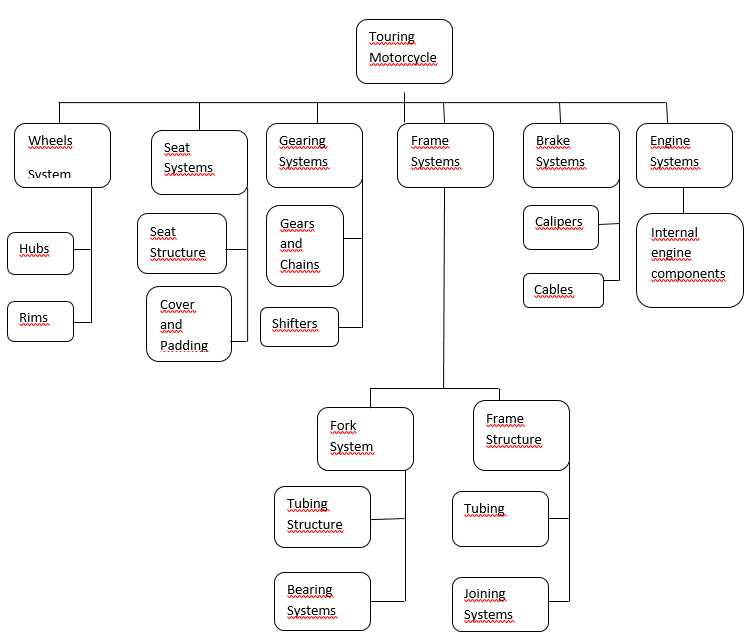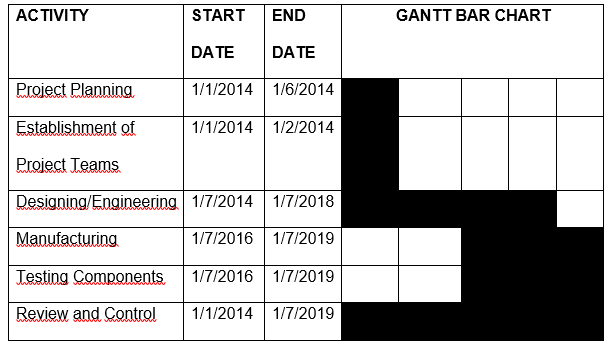Project Scope and Management Plan
Project scope refers to the range of coverage for the entire undertaking. In essence, the major intention of Vis-Hawal Motorcycles Company is to diversify its production portfolio. The production of powerful engines will require an effective planning and management of the project scope. According to Kerzner and Saladis (2013), management of project scope entails the definition of processes and procedures involved in the plan. In addition, the confirmation of these processes, verification, and controlling functions are carried out at this project phase.
Vis-Hawal Motorcycles is a producer of motorbikes of middle weight category. The size of the engines fitted in these machines range from 500cc to 1000cc. The company intends to expand into the production of touring class motorcycles with larger engines. The new machines are expected to have a capacity of 1100cc and above.
The realization of this production goal is projected over a period of five years. As a result, an effective and efficient project methodology is required (Chiu, 2012). The proposed approach is the concurrent engineering method. According to Kerzner (2013), concurrent engineering involves a process where work is performed in parallel as opposed to in series. The main advantage of this methodology is its ability to compress the project schedule. Consequently, it reduces the chances of serious risks occurring in the process.
Concurrent engineering methodology will supplement and be integrated with the strategy proposed earlier. The approach proposed for the project entailed the stage process. Under this strategy, various activities in the plan will be undertaken in stages and gates. On its part, the concurrent style will ensure that present operations of the company “do not become slack” or interfered with by the project (Chiu, 2012, p. 42). The methodology will also facilitate project activities either in parallel or in series. In this case, the tasks will be undertaken in series.
The project will cover production of complete touring class motorcycles. Currently, the company is producing middleweight motorcycles. What this means is that some of the essential technology needed for the new project is available. Consequently, the research and design department will play one of the most significant roles of designing the engines. Other departments will create sub-sections meant to deal with the project. The projectized organizational structure will enhance cooperation and compliance among the other departments.
The lead change manager (project manager) will oversee the entire process. The proposed project scope and management plan will improve control in the company, resulting in the completion of the project within the budget and in a timely manner (Chiu, 2012).
The Workforce Needed for the Vis-Hawal Motorcycles Manufacturing Switch Project
According to Kerzner (2013), the success of a project is heavily dependent on the individuals and the leaders responsible for management of the various functions. A project team or staff should be suited to their roles if the ultimate objectives are to be realized. One of the most important stakeholders is the project manager. According to Kerzner and Saladis (2013), a project manager is responsible for the overall administration of the process. Some project administrators are highly productive in projects with long durations and which require slow decision-making (Chiu, 2012).
Other managers are productive in short duration projects, which exhibit an environment characterized by constant pressure (Kerzner & Saladis, 2013). In the case of Vis-Hawal Motorcycles, the project manager should be a well seasoned individual. They should exhibit the ability to be productive in a long duration undertaking.
The staff involved in the project will vary depending on the number of full-time and part-time team members. The research and design employees will be dedicated to the project for the entire development duration. Part-time project team members will include production staff concerned with the actual manufacturing of the various prototypes developed over the entire implementation duration. Technical managers will be essential in coordinating and managing procedural resources (Chiu, 2012). The professionals ensure the completion and achievement of the project deliverables (Kerzner & Saladis, 2013).
Departmental process experts undertake analysis and specification of requirements (Chiu, 2012). Project coordinator, on the other hand, assists the manager in scheduling meetings and ensuring that all stakeholders are involved in the process (Kerzner & Saladis, 2013). In addition, project managers assist in the development of a test plan. A change management consultant is also needed to implement the project envisaged by Vis-Hawal Motorcycles. According to Chiu (2012), the professionals are concerned with the development and dissemination of stakeholder information.
Team Building Strategies for the Project
Identification of Team Building Characteristics
To effectively realize the project objectives, managers require a strategic model or framework to enhance the performance of team members (Mealiea & Baltazar, 2005). According to Sundstrom, DeMeuse, and Futrell (1990), there are various team building strategies. One of them entails the identification of team building characteristics, which are considered as major predictors of the success of the project.
Vis-Hawal Motorcycles’ project manager should focus on the desirable characteristics. They should make these traits part of the work environment. Consequently, the attributes of the team member will be balanced and the necessary resources availed to complete the project (Sundstrom et al., 1990).
Measuring the Prevailing Environment
Team building in Vis-Hawal Motorcycles’ project can also be enhanced through the assessment of existing team climate characteristics (Mealiea & Baltazar, 2005). Consequently, the profile of existing teams can be developed and used in managing the members.
Using Pre-Determined Standards
The other team building strategy essential for the project involves using pre-established standards in selecting the appropriate intervention sequences (Sundstrom et al., 1990). Intervention is needed to change deficient climatic attributes in the team.
Accountability
Holding team members accountable in relation to delivery can also help in managing the project (Mealiea & Baltazar, 2005). The managers should inform the team members that they are not only accountable to them, but also to their colleagues.
The Role of the Project Manager
The major responsibility of project managers involves the general management of the entire undertaking. The administrators are involved in planning, organizing, directing, controlling, and staffing as far as the undertaking is concerned (Chiu, 2012). On top of these duties, Vis-Hawal Motorcycles’ project manager will be required to undertake other roles. Some of these additional tasks include identifying and addressing problems affecting the project (Kerzner, 2013). In addition, the manager is expected to strike a balance between time, personnel, and other resources needed for the project.
Vis-Hawal Motorcycles’ project administrator should exhibit several attributes relevant to this particular undertaking. Some of these essential attributes entail flexibility and adaptability. The project brings together participants from various backgrounds. In addition, it is a longer term undertaking. Consequently, the manager requires these attributes to help them work under the various environments associated with these experts.
The professional will also need to be ambitious, forceful, and activity oriented (Kerzner, 2013). In addition, they should be an effective communicator and integrator. The attributes will enable them exercise their authority effectively during the project implementation (Toader, Brad, Adamov, Marin & Moisa, 2010).
The Importance of Identifying Critical Paths in Projects
Kerzner and Saladis (2013) provide a working definition of the critical path method (CPM). According to Kerzner and Saladis (2013), the method refers to a technique used in analyzing projects. The approach determines the longest sequence of tasks through the project’s network. The major objective of CPM is to assist in the identification of the best way time required for performing routine or repetitive tasks in an organization can be reduced.
After determining the ‘slack’ time, resources can be channeled to activities that are more urgent. Kerzner (2013) defines slack time as the duration by which a task can be delayed without significantly affecting the start date of the next activity. The critical path method helps the manager to identify all the tasks impacting directly on the ‘end date’ of a project. According to Chiu (2012), CPM highlights all the activities that require to be completed on time in order for the project to be realized within the schedule.
CPM also identifies various tasks that can be delayed if resources require to be reallocated to address missed activities (Kerzner & Saladis, 2013). Consequently, project managers are able to allocate resources based on priority and significance of the tasks to the overall project (Toader et al., 2010).
Elements of a Work Breakdown Structure and Pricing and Costing Strategy
Work Breakdown Structure (WBS) defines the various packages of activities associated with a project. It also develops and tracks down the cost and schedule of the project (Chua & Godinot, 2006). WBS breaks down tasks into various activities. Each of the tasks has its own responsible institution, a manager, a technical scope, a schedule, and a geographic section (Hillson, 2003). In essence, WBS determines the work needed to create the project’s deliverables. The deliverables are pre-determined in the project requirements (Chua & Godinot, 2006).
WBS is provided as an outline in a logical and hierarchical manner. It provides the manager with an approach, methodology, strategy, or a template for executing the project. In addition, the project costing and pricing strategy can be drawn based on WBS.
Vis-Hawal Motorcycles’ Project Work Breakdown Structure, Gantt Chart, and Assigned Resources
Work Breakdown Structure
A WBS outlines the project’s deliverables. The WBS for Vis-Hawal Motorcycles’ project can be presented as follows:

Gantt Chart
The figure below illustrates the Gantt Chart for the project:

Project Assigned Resources
The following are the main resources needed for the execution, facilitation, and completion of the project:
- Time
- Personnel
- Funding and financial resources
- Raw material for instance metals
References
Chiu, A. (2012). Ten tips for smart project managers. Chemical Engineering, 119(1), 40-43. Web.
Chua, D., & Godinot, M. (2006). Use of a WBS matrix to improve interface management in projects. Journal of Construction Engineering and Management, 132(1), 67-79. Web.
Hillson, D. (2003). Structuring a breakdown: The risk management RBS. Project Magazine (Association for Project Management), 15(7), 12-14. Web.
Kerzner, H. (2013). Project management: A systems approach to planning, scheduling, and controlling (11th ed.). Hoboken, NJ: Wiley. Web.
Kerzner, H., & Saladis, F. (2013). Project management workbook and PMP/CAPM exam study guide (11th ed.). Hoboken, NJ: Wiley. Web.
Mealiea, L., & Baltazar, R. (2005). A strategic guide for building effective teams. Public Personnel Management, 34(2), 141-183. Web.
Sundstrom, E., DeMeuse, K., & Futrell, D. (1990). Work teams: Applications and effectiveness. American Psychologist, 45(1), 120-133. Web.
Toader, C., Brad, I., Adamov, T., Marin, D., & Moisa, S. (2010). The main causes which lead to success or failure of a project. Scientific Papers: Animal Science and Biotechnologies, 43(2), 449. Web.
